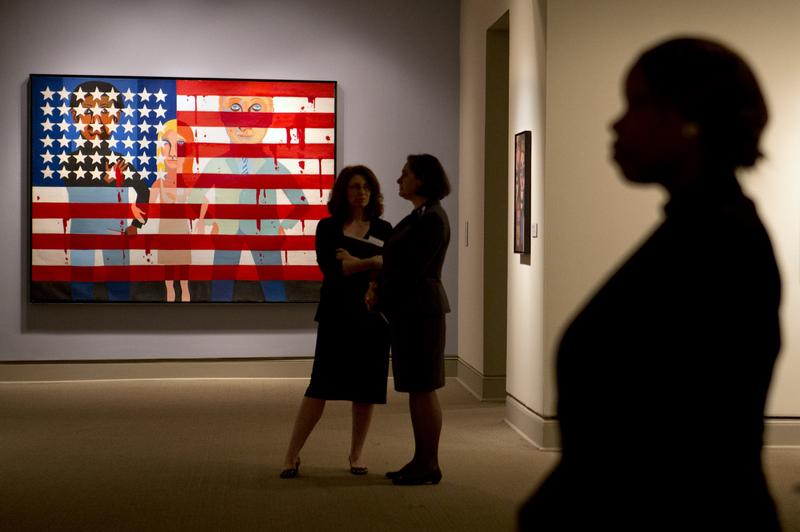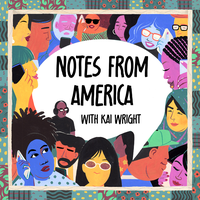Faith Ringgold Creates Space for Black Americans

( AP Photo/Jacquelyn Martin )
Kai Wright: It's Notes from America. I'm Kai Wright. Last year, the New Museum here in New York held this incredible 50-year retrospective on the artist Faith Ringgold. It was a gorgeous collection of work that told the story of the American people in the 20th century really, and specifically, a history of Black people, and how and whether we fit in this country. I wanted to learn more about Faith Ringgold's work. I took a trip to see the exhibit with our producer, Rahima Nasa, and to see one of Faith Ringgold's famous story quilts. It was called Dancing at the Louvre.
Rahima Nasa: It's this large quilt, and in the center of it is a scene that's painted on. There's borders around the quilt that are made up of different pieces of floral fabric.
Kai: The quilt depicts two Black women and three little Black girls who have their arms stretched out like they are dancing around. They're wearing these colorful dresses, and they just look so, so happy. Behind them is a row of three famous paintings of white women, including The Mona Lisa. Like much of Faith Ringgold's work, the whole scene is just meta. It's a semi-autobiographical artistic comment on art itself.
Rahima wanted me to see it and share it with all of you because she spoke about it with Faith Ringgold's daughter, Michele Wallace. Now, Michele is herself a very big deal. She's an art historian and a feminist scholar. She wrote a really important book about sexism within the Black nationalist movement. It's called Black Macho and the Myth of the Superwoman. When Michele and Rahima spoke, they talked about Michele's mom, about the life and the work of Faith Ringgold, starting with this scene of a joyful Black family dancing at the Louvre.
Michele Wallace: It compresses many things in our lives because, number one, mother took my sister and I, and my grandmother, to Paris. I just think it's this incredible meditation on motherhood.
Rahima: Here's a story behind the quilt. As Michele tells it, it's 1961, Michele is 10, and her sister Barbara is 9. Faith drags all of them to Paris, her own mother included, because she's trying to find herself as an artist and she wants an up-close look at what her teachers say is the world's most important art.
Michele: My mother was determined that we were going to see The Mona Lisa, and we were determined that we were going to get outside and get some ice cream. In other words, this Dancing at the Louvre is a derivation of our first situation in the Louvre, but it's also about the opportunities. How could you make a life for a Black woman that would end in her being a famous artist?
Faith Ringgold: What I went there for was-
Rahima: Here's Faith in 2016 again.
Faith: -is I was trying to figure out, do you really want to be an artist? Are you really going to do this struggle? You want that really, or what do you want?
Rahima: Faith decides, yes, she does want to be an artist, but if she's going to struggle, she's going to do it on her own terms. That means truly engaging with the world she inhabits as a Black woman.
Michele: My mother is a little bit like Jesus Christ in this sense that she is willing to address and speak to whomever will listen. She was born in 1930 at 222 West 146th Street between Bradhurst and 8th Avenue. My mother grew up around wonderful storytellers.
Rahima: This is during the Harlem Renaissance. Duke Ellington, Langston Hughes, Zora Neale Hurston, so Faith grows up in a community of musicians, painters, and poets. This creative spirit spilled into her home too, where Faith's mother was a towering figure.
Michele: Whose name was Willie Posey, and who I called Momma Jones.
Rahima: Willie Posey loved to design clothes and she had an incredible fashion sense. In one old photo, Willie is seen wearing this gorgeous A-line dress with white gloves, a beaded necklace, and strappy black heels. She has her hands on her hips and a big grin on her face.
Michele: She was really a housewife. She was designing her children's clothing and dressing them up. All the early photographs are them dressed head to toe in my grandmother's fashions.
Rahima: Faith's father, Andrew Louis Jones, he was a truck driver for the Department of Sanitation.
Michele: All those city jobs were great. There was a kind of a bourgeoisie who worked for the Sanitation Department, post office, all those kind of jobs Black men had. Those Black men who had those jobs were able to take care of their families during the Depression. I think that people think of the Harlem Renaissance and the Depression as mutually exclusive, one followed the other. Actually, they occurred at the same time. You got Jacob Lawrence, one of our great artists who is part of the Harlem in which my mother grew up.
Rahima: Faith experiences era a little differently because she spent a lot of time at home. She was diagnosed at a young age with pretty bad asthma.
Michele: She was homeschooled by my grandmother, which is partly accounting for their tremendous closeness. The doctors just simply felt that the best way to keep her from being sick was to not expose her to other children. My grandmother taught her how to sew and how to make dolls.
Rahima: This became a way to encourage faith to be creative. Willie Posey gave her paint and crayons to keep her occupied. Her dad bought Faith her first easel. When she's a teenager, she decides she's going to be an artist. In 1948, she enrolls at City College and majors in art education. She sets about making a life. She gets married, has two daughters, gets divorced, graduates, teaches art in public schools, raises two little girls by herself, and all the while she's still trying to make her own art.
Michele: Now, through all this time, she doesn't have a studio. Her studio, in fact, was a closet in our apartment. She painted boats and landscapes. I remember her making a lot of portraits of herself with pastels. When she really took off is when she married Burdette Ringgold, and you know exactly when this happens. This happens in 1962. Then she becomes Faith Ringgold, and that is when she begins to find herself.
Rahima: Something else is happening that year.
Narrator: 200,000 people converge on the nation's capital to rally for civil rights. They come by train, they come by bus, and by air.
Michele: We had the civil rights movement, you had Martin Luther King, you had non-violent resistance. You had, especially in the North, a hope that there would be a peaceful resolution to integration, but there wasn't going to be. It was going to be violent. There were riots going on. Martin Luther King will be killed in 1968, John F. Kennedy in '63. Very important, Malcolm X killed in 1965. Very important in Harlem, a major influence on my mother and my father, in the Ringgold household. They knew him. It was just like, I don't know what, a vegetable soup of American violence. Rap Brown, what did he say? That violence is as American as cherry pie.
Rahima: In the summer of 1967, a series of uprisings protesting racial injustice and police brutality spread across the country.
Narrator: New Jersey's largest city, Newark, for 5 consecutive days a night, at least 24 persons are killed. More than 1,800 [crosstalk]
Rahima: During that summer, Faith makes one of her most famous works, which was her way of documenting this moment. Faith named this painting Die. It's massive, spans 12 feet. There's 10 adults evenly divided between Black and white. There are kids cowering as adults fight, their clothes are splattered with blood. It looks like they're trying to kill each other or run away.
Michele: What's funny is when mother did those paintings, I thought they were about the South. I didn't know that they were about the North. I believed what everybody else thought, that racism and stuff was down South somewhere, so she must be painting about the South.
Rahima: Faith knew racism was very real up North. In fact, she was facing it in the mainstream art world because she could not get attention for her work in the galleries and museums. They were closed off to women, especially Black women, and to this kind of politics. Faith begins to organize and speak out.
Michele: She definitely went to protesting because she couldn't get in anything, and she wasn't going to just sit home with the art piling up, and take it.
Rahima: In 1970, Faith and a group of other artists protested the Whitney's annual exhibition, which later became the Biennial. This show is a big deal for American artists, but the majority of the artists exhibited at the time were white or men, and Faith wasn't having it. Here she is talking about it in an interview for the documentary series, Makers.
Faith: Our demand was that the Whitney Biennial should be 50% women.
Rahima: As Faith tells it, Michele helped her come up with that number. While Faith did her best to shield her daughters from racism, she also taught them to be activists.
Faith: She's a kid, and she's doing her homework. I said to Michele, I said, "What percentage of women do we demand?"
Michele: Then I said, 50%. Why? Because in the population of the world, women are 50%. In fact, they're more than 50%.
Faith: I said, "Oh, my God. This poor kid. [chuckles] She's too young to be involved in all this." Now, this was outrageous because their thing was no women. You can't demand 50%. I said, "Really?" I said, "What? Say it again."
Michele: Why wouldn't it be 50%? I can understand why it might be a little bit concerning, but let's face it. If we're going to demand something, it's 50%. I didn't realize how shocked she was by it and how shocked everybody was by it.
Rahima: They didn't get 50% in the end, but they did get 20%, which was way more than what anyone expected.
[music]
Rahima: In 1981, Faith's mother, Willie Posey, dies at the age of 78. Her death hits the whole family hard. Faith is buried in grief. She channels that grief into making something unlike anything she had done before.
Michele: She's always starting over again, this restarting, this generational restarting. How do I go on with my life now that my mother, who is my absolute muse, her muse, the woman who generated everything that she was, how does she go on with her life and her work?
Rahima: She's absolutely devastated by this loss. She decides to return to her roots, to the thing that connects so many women in her family, stitching together pieces of fabric to make something new, quilting. It went back generations in the family. Willie Posey actually learned it from her mother, and she and Faith had worked on a quilt together a year before her death.
Michele: My understanding is that her grandmother taught her, Betsy. Betsy had everything. Betsy was rich. [laughs] This was, Betsy was a dressmaker. She was a former slave.
Rahima: Betsy's own mom, so, Faith's great-grandmother taught Betsy how to quilt.
Michele: They all made clothes. They were dressmakers. They obviously sewed as slaves, and they both were about 100 when they died. My grandmother knew them.
Rahima: Now, Faith decides to bring quilting into her art in a different way. She makes a piece called, Who's Afraid of Aunt Jemima? It's based on a minstrel show character that up until recently was used to sell pancake syrup. This elaborate quilt has a border made of scraps of colorful fabric, and she's painted figures directly onto the fabric. She's using the fabric as her canvas. It's a huge innovation and a huge departure from anything else that's happening at the art world at the time. More than that, it's also when faith begins to use text in her artwork. Faith wanted Michele to help her write the text about Aunt Jemima.
Michele: I said, "No, mother, I cannot do that." She said, "Aunt Jemima is our feminist hero." I said to her, "She's not my feminist hero. I don't know what you're talking about."
Rahima: [chuckles] Faith writes the story herself without Michele's help. She uses text on the quilt to reimagine Aunt Jemima as a successful entrepreneur and matriarch. This is the first Faith Ringgold story quilt. She'll be world-famous for this, but she was scared of what she'd done.
Michele: She had hid it. She hid it. She was afraid to show it to anybody. Moira came and stayed with her.
Rahima: Moira is a close friend of Faith's.
Michele: She said to Moira, "I feel guilty because, under your bed, I'm hiding this work of art. I don't know what it is or why it is, but I feel guilty about it." Moira said, "Take it out. Let me see it." It was, Who's Afraid Of Aunt Jemima? Moira loved it. With, Who's Afraid of Aunt Jemima? here comes my grandmother's voice and all the elders in our family coming out of my mother's mouth in a way. I marvel at it now that her grieving process produced so much work. It produced the story quilts, it produced the abstractions. It became my mother's new medium.
Rahima: Faith's Story quilts continue to get more personal. In 1991, she tells one of her most ambitious stories in a series called The French Collection. The first quilt in that collection is Dancing in the Louvre, the one I showed Kai earlier, the one that is inspired by Michele and Faith's trip to Paris. It's yet another turning point for her art.
Michele: What she was doing is she was starting her career all over again at 60. She'd already been an artist 30 years. It would be a midpoint. It could have been as far as she'd ever get, but The French Collection is a projection of where she plans to go with her career.
Rahima: Faith does go on to great places. Her work has been exhibited at the Whitney, The Guggenheim, The Tate The Museum of Modern Art added Die to its permanent collection. It hangs in the same room as a work by another great artist. You may have heard of him, Pablo Picasso. Her story quilt, Tar Beach, was adapted into a best-selling children's book. At 91, she's still making work. She's been inspired by the protests following George Floyd's murder. She has a lot more to say about racial injustice and the American people.
Michele: She has left me a wonderful, wonderful, detailed roadmap of her thoughts and her passions. It's for me to interpret the work and talk about it, and try helps explain it or understand it. Whereas she's just lightyears ahead of people in this regard.
Kai: That was art historian Michele Wallace talking with our producer Rahima Nasa about the life and career of Faith Ringgold. Notes from America is a production of WNYC studios. You can follow us wherever you get your podcast and join us on Instagram @noteswithkai. Jared Paul does music and mixing for our show. Editing, producing, and reporting courtesy of Karen Frillmann, Vanessa Handy, Regina de Heer, Rahima Nasa, Kousha Navidar, and Lindsay Foster Thomas. I am Kai Wright. Thanks for spending time with us tonight, and Happy 2023.
[music]
Copyright © 2023 New York Public Radio. All rights reserved. Visit our website terms of use at www.wnyc.org for further information.
New York Public Radio transcripts are created on a rush deadline, often by contractors. This text may not be in its final form and may be updated or revised in the future. Accuracy and availability may vary. The authoritative record of New York Public Radio’s programming is the audio record.





